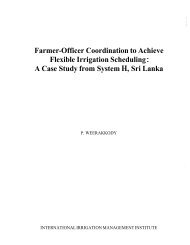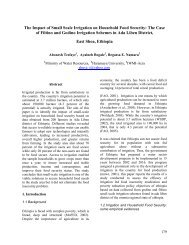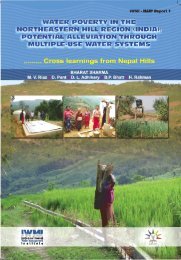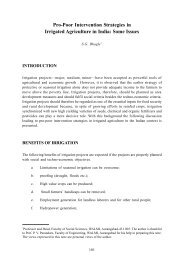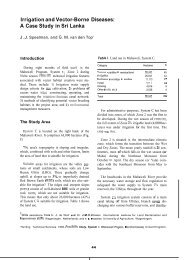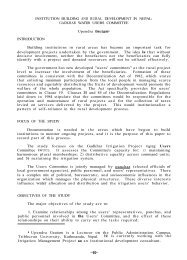David Molden, R Sakthivadivel and M Samad - International Water ...
David Molden, R Sakthivadivel and M Samad - International Water ...
David Molden, R Sakthivadivel and M Samad - International Water ...
You also want an ePaper? Increase the reach of your titles
YUMPU automatically turns print PDFs into web optimized ePapers that Google loves.
<strong>Molden</strong>, <strong>Sakthivadivel</strong> <strong>and</strong> <strong>Samad</strong>: Accounting for Changes in <strong>Water</strong> Use<br />
Table 2: Basin characteristics<br />
Particulars<br />
Fuyang River Basin<br />
East Rapti<br />
China<br />
Nepal <br />
Type of basin Sub-basin of Huihe<br />
Of Narayani<br />
Southern Basin<br />
Basin<br />
i Basin area<br />
22814 SQ. km.<br />
312.0 sQ. km. <br />
L<strong>and</strong> use cover <br />
More than 60% forest<br />
I Mean annual<br />
! precipitation<br />
Average annual potential<br />
evapotranspiration<br />
i Population density<br />
Percent involved in <br />
agriculture <br />
Farm size per household <br />
569.2mm<br />
800mm.<br />
685/sq. km.<br />
-<br />
-<br />
1866 mm<br />
1460 mm<br />
212/sq. Km. <br />
80 per::ent <br />
0.9ha<br />
Major crops grown Wheat <strong>and</strong> corn, cotton, Wheat, (Ice <strong>and</strong> maize<br />
oil bearing crops<br />
Average yieldslha 4.26 tlha - wheat 1.85 to 2.5 tlha<br />
4.90 tlha - corn <br />
Major issues 1. Physical water 1. Concern about<br />
scarcity<br />
impacts of increased<br />
2. Inter-sectoral diversion on natural<br />
competition for water habitat.<br />
3. <strong>Water</strong> pollution 2. Population<br />
problem due to rural resettlement <strong>and</strong> its'<br />
industrialisation<br />
impact on present<br />
4. Over-exploitation of water use patterns.<br />
groundwater 3. Soil degradation in<br />
catchment <strong>and</strong><br />
sedimentation<br />
4. Seasonal scarcity<br />
7.1 East Rapti, Nepal<br />
East Rapti River BaSin (ERB) is a part of the Chitwan valley within the inner tarai of<br />
Nepal. draining an area of 3,120 sq, km. The East Rapti river originates from the<br />
Mahabarat range of mountains (MSL 1,500 m), traverses 122 km <strong>and</strong> meets the<br />
Narayani River, one of the four major rivers in Nepal, at MSL 140 m. The Narayani,<br />
called the G<strong>and</strong>ak in India, eventually discharges into the Ganges River. Forests<br />
cover 60% of the area. The average annual rainfall is 1,937 mm, while the average<br />
annual potential evapotranspiration for the basin is 1,460 mm. Rainfall is concentrated<br />
during six months of monsoon period from middle of May to end of October. July<br />
<strong>and</strong> August are the rainiest months receiving nearly half the annual rainfall. Rainfall<br />
during the dry period of six months is only 7 percent of annual rainfall. The river<br />
hydrograph at the confluence of the Narayani River is presented in Figure 3.<br />
82



